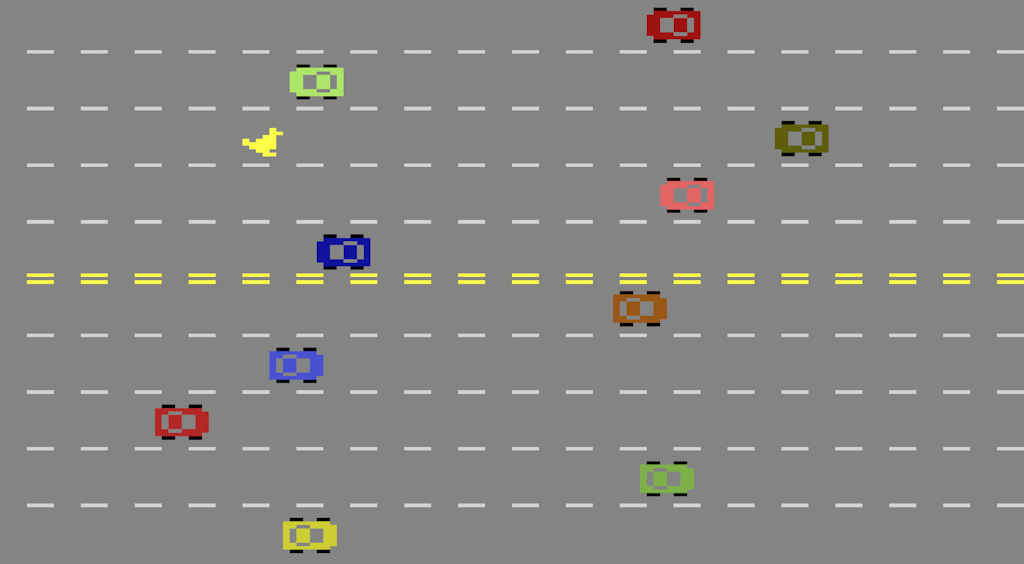
Console Gaming History Adventure: 1981
It’s taken me a lot longer than it did for 1980, but I’ve finally completed 1981. While there were only 58 new cartridges to get through, it took me so long because I had 120 arcade games to play too before I could consider this year finished! I’ve always intended console games to be the focus of this project, so I’m looking forward to the year they finally overtake arcade games in popularity, but that year is not 1981. 😕
With 1981 complete, I’ve now played a grand total of 625 titles – arcade and console! I never thought I’d make it this far, and it’s been a wild ride! This year’s games continue the trend of better graphics, better gameplay, and better overall polish. There’s also been a significant spike in the average game’s unique character and charm, something I particularly appreciated with how I’m examining these games as an art form as well as playing them! Overall, I really noticed the difference in the quality of the 1981 titles and I’m looking forward to things continuing to get even better!
New Consoles
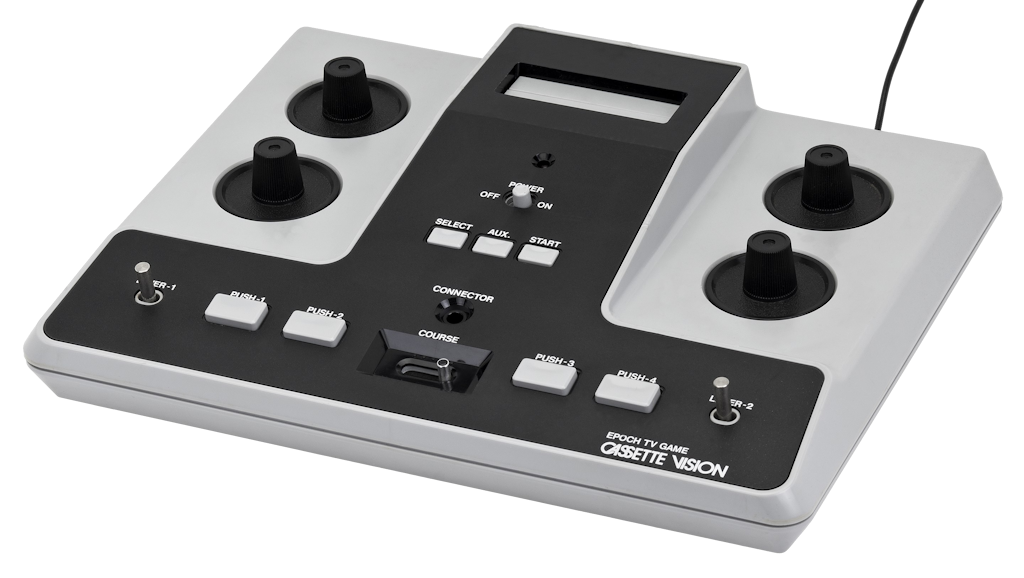 The only home console release I can find for this year is the Epoch Cassette Vision, a Japanese console that retailed for around 13,500JPY (19,082JPY in today’s money). That’s pretty cheap even by today’s standards, let alone 1981, and it shows in just how terrible the system’s graphics were. Only 12 games were ever released for it, but it was still popular in Japan, selling over 400,000 units and becoming Japan’s best-selling console until the release of the Famicom 2 years later. And hey – it’s actually got two-axis analog movement support! 😃
The only home console release I can find for this year is the Epoch Cassette Vision, a Japanese console that retailed for around 13,500JPY (19,082JPY in today’s money). That’s pretty cheap even by today’s standards, let alone 1981, and it shows in just how terrible the system’s graphics were. Only 12 games were ever released for it, but it was still popular in Japan, selling over 400,000 units and becoming Japan’s best-selling console until the release of the Famicom 2 years later. And hey – it’s actually got two-axis analog movement support! 😃
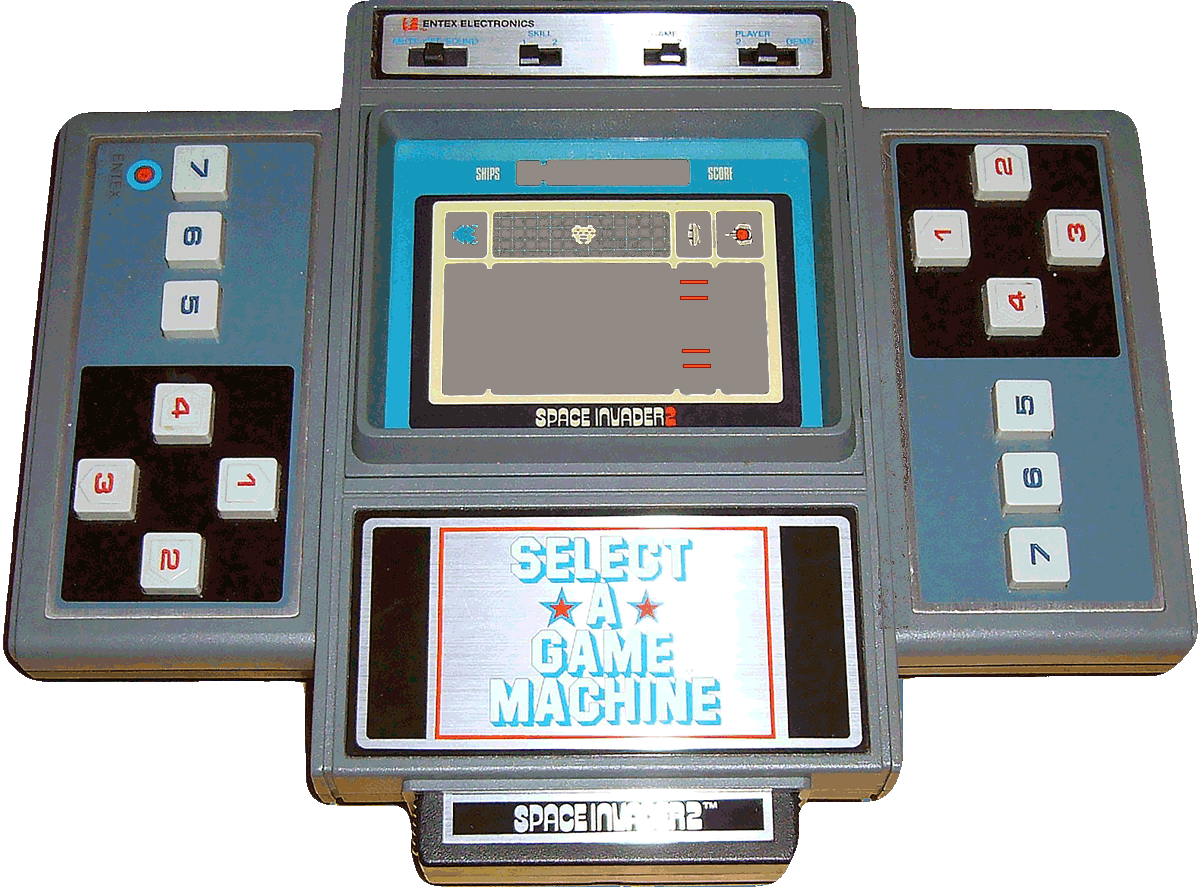 (NO ACCESS) Also released this year (and I nearly missed including it!) is another portable game console, this one called the Entex Select-A-Game. Like the Milton Bradley Microvision we covered in 1979, the Select-A-Game was not very successful, with only 8 games produced for the system, and only 6 of them actually released before the console flopped by the end of the year thanks to a nasty lawsuit from Coleco and Midway over the inclusion of Pac-Man. It was clearly bigger and bulkier than the Microvision and had an even smaller screen resolution of 7 x 16. At least it was a bit cheaper at 54.99USD (179.03USD today). What can I say? This was clearly not the time for a portable game console just yet.
(NO ACCESS) Also released this year (and I nearly missed including it!) is another portable game console, this one called the Entex Select-A-Game. Like the Milton Bradley Microvision we covered in 1979, the Select-A-Game was not very successful, with only 8 games produced for the system, and only 6 of them actually released before the console flopped by the end of the year thanks to a nasty lawsuit from Coleco and Midway over the inclusion of Pac-Man. It was clearly bigger and bulkier than the Microvision and had an even smaller screen resolution of 7 x 16. At least it was a bit cheaper at 54.99USD (179.03USD today). What can I say? This was clearly not the time for a portable game console just yet.
Returning Consoles
This year marks the triumphant return of the Bally Professional Arcade thanks to a deal between Bally and a company called “Astrovision”. The product now came with a BASIC programming cartridge and marketed under the name “Bally Computer System”, though it was really still just a gaming console. While it’s nice to see the once very advanced system come back, the rest of the market had largely caught up to its capabilities by now, and it would be leapfrogged by multiple new console releases only a year later. 😕
The dominant platform this year was the Atari 2600 with 19 new games. It’s becoming quite noticeable how much better these newer titles look than the older ones thanks to tricks and workarounds that programmers developed over time to squeeze more out of the system than it was ever meant to do. It still pales in comparison to what was available on arcade machines of the time though.
The Intellivision also had 7 new games come out. It seems by this point they had figured out that their games were overly complicated. The newer games dial back the use of the console’s signature numeric keypad and they are much easier to pick up and play! I quite appreciated the improvement!
The Odyssey² had a few new games too, and they are as awful as ever. 😐
This is the last year with new games (discounting much later, very rare homebrews and aftermarket titles) for the Fairchild Channel F. Amazing it lasted as long as it did!
Noteworthy Games
With the improvement of the average game’s quality for 1981, it makes sense for my standards to bump up a bit as well, so I have a similar number of titles to spotlight this year:
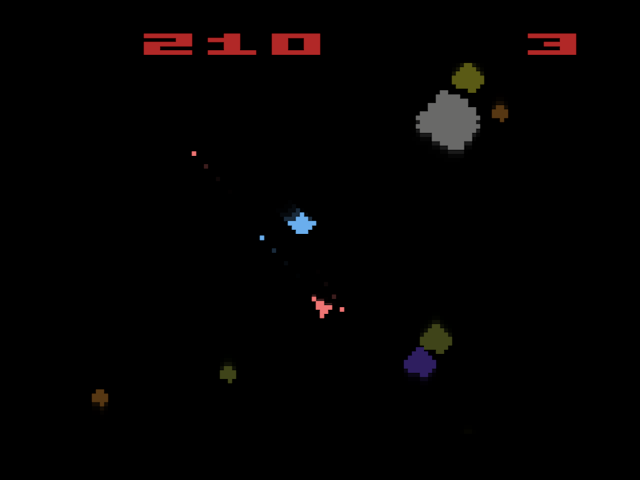 Probably the most famous console release this year is a port of the arcade game Asteroids for the Atari VCS. The public really went gaga for this one, and along with last year’s port of “Space Invaders”, Asteroids did a lot to contribute to the popularity of the Atari VCS and of console gaming in general, pushing the medium even further into the mainstream. Personally, I don’t think the port is really all that spectacular, but I guess it isn’t bad – just so-so. As part of converting the vector graphics of the original arcade game into pixel graphics for the VCS’s low-resolution display, Atari also added a variety of coloring to the objects on the screen (the original game was black and white).
Probably the most famous console release this year is a port of the arcade game Asteroids for the Atari VCS. The public really went gaga for this one, and along with last year’s port of “Space Invaders”, Asteroids did a lot to contribute to the popularity of the Atari VCS and of console gaming in general, pushing the medium even further into the mainstream. Personally, I don’t think the port is really all that spectacular, but I guess it isn’t bad – just so-so. As part of converting the vector graphics of the original arcade game into pixel graphics for the VCS’s low-resolution display, Atari also added a variety of coloring to the objects on the screen (the original game was black and white).
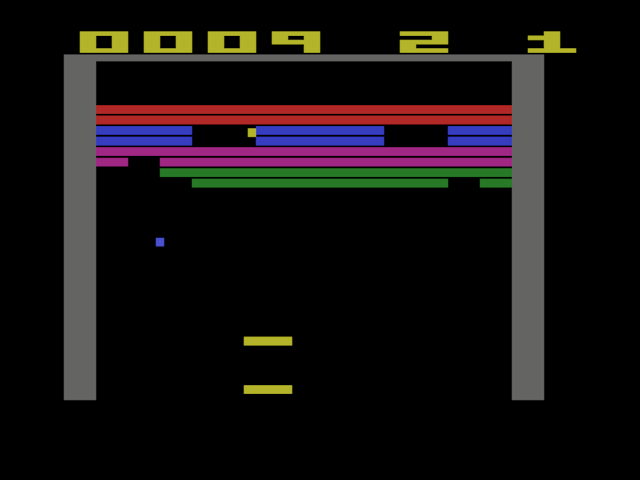 Another good arcade port to the Atari VCS that came out this year is Super Breakout, based on the arcade game of the same name from 1978, which in turn is a sequel to Atari’s 1976 arcade hit “Breakout”. Super Breakout offers a wider variety of play modes that put different spins on the original formula. The console version for the VCS uses the paddle controller for analog movement, making it possible to aim your paddle with precision while still letting you dart it quickly from one end of the playfield to the other. I really wish analog movement was more of a thing back then. Even the arcade games rarely used it where it would really make a lot of sense. 😞 Anyway, Super Breakout is a nice solid breakout game, and other than the incredibly weird space plot that exists only in the manual (the arcade version used a typical criminal prison break theme), I have no complaints.
Another good arcade port to the Atari VCS that came out this year is Super Breakout, based on the arcade game of the same name from 1978, which in turn is a sequel to Atari’s 1976 arcade hit “Breakout”. Super Breakout offers a wider variety of play modes that put different spins on the original formula. The console version for the VCS uses the paddle controller for analog movement, making it possible to aim your paddle with precision while still letting you dart it quickly from one end of the playfield to the other. I really wish analog movement was more of a thing back then. Even the arcade games rarely used it where it would really make a lot of sense. 😞 Anyway, Super Breakout is a nice solid breakout game, and other than the incredibly weird space plot that exists only in the manual (the arcade version used a typical criminal prison break theme), I have no complaints.
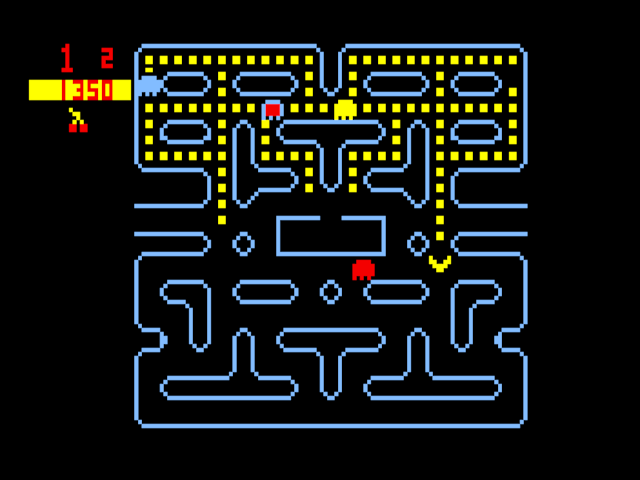 Not that the Atari VCS was the only console with some high quality arcade game ports. Released this year for the Bally Home Library Computer is Muncher, a clear copy of Pac-Man. I chose to spotlight this game because I think it’s a good example of where console games were at this point in comparison to their arcade counterparts. The lower resolution screen means it’s not really possible to give the ghosts eyes (though they do have simple eyes when they turn blue) and the limit on the number of colors that can be shown at once also affects the distinct look of each ghost. But the port otherwise does a pretty good job of replicating the look and feel of the original game. While these days we can easily play the real thing at home whenever we want, back then, I am sure gamers appreciated being able to play popular titles like this without having to make the trek to the local arcade in whatever form could make that possible.
Not that the Atari VCS was the only console with some high quality arcade game ports. Released this year for the Bally Home Library Computer is Muncher, a clear copy of Pac-Man. I chose to spotlight this game because I think it’s a good example of where console games were at this point in comparison to their arcade counterparts. The lower resolution screen means it’s not really possible to give the ghosts eyes (though they do have simple eyes when they turn blue) and the limit on the number of colors that can be shown at once also affects the distinct look of each ghost. But the port otherwise does a pretty good job of replicating the look and feel of the original game. While these days we can easily play the real thing at home whenever we want, back then, I am sure gamers appreciated being able to play popular titles like this without having to make the trek to the local arcade in whatever form could make that possible.
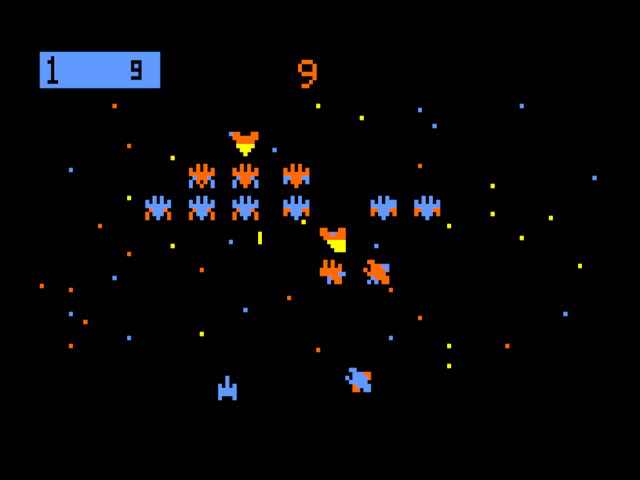 Perhaps even better at showing off what the Bally Home Library Computer can do is with their port of Galaxian, which they called Galactic Invasion. The lower resolution alien ships still retain a lot of the same character, though again, the limited number of colors affects how distinct they can look from each other. The animation has a similar smoothness to the original, and I think they did a pretty good job!
Perhaps even better at showing off what the Bally Home Library Computer can do is with their port of Galaxian, which they called Galactic Invasion. The lower resolution alien ships still retain a lot of the same character, though again, the limited number of colors affects how distinct they can look from each other. The animation has a similar smoothness to the original, and I think they did a pretty good job!
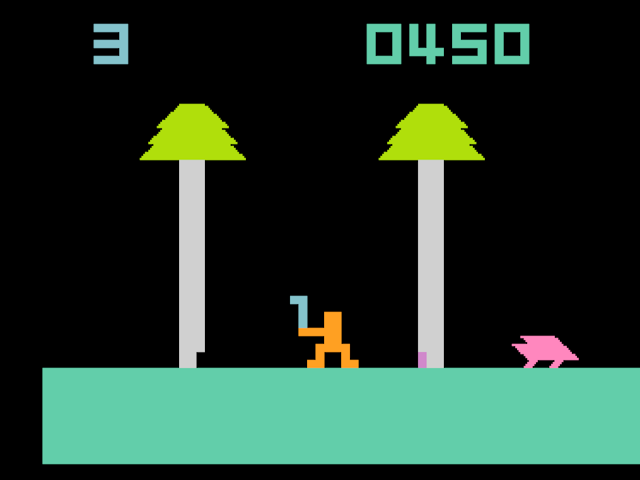 Not that games need good graphics to be entertaining, as 木こりの与作 / Kikori no Yosaku (Yosaku the Lumberjack) for the Epoch Cassette Vision shows us! This ugly but charming little game was a good quick laugh. You are a lumberjack and have to chop down trees, which appear on the screen two at a time. In your way are worms that come from the ground to try and kill you, boars that rush across the screen to try and kill you, and birds that fly overhead to try and poop on you, which will stun you if you can’t avoid it, leaving you temporarily helpless against the worms and boars. This was the most popular game for the Cassette Vision. It’s apparently an unauthorized clone of an arcade game that I unfortunately didn’t have access to, though it proved way more popular with the Japanese than the arcade game did. The arcade game itself is based on the song “Yosaku” by Japanese singer Saburō Kitajima about a man named Yosaku who cuts trees.
Not that games need good graphics to be entertaining, as 木こりの与作 / Kikori no Yosaku (Yosaku the Lumberjack) for the Epoch Cassette Vision shows us! This ugly but charming little game was a good quick laugh. You are a lumberjack and have to chop down trees, which appear on the screen two at a time. In your way are worms that come from the ground to try and kill you, boars that rush across the screen to try and kill you, and birds that fly overhead to try and poop on you, which will stun you if you can’t avoid it, leaving you temporarily helpless against the worms and boars. This was the most popular game for the Cassette Vision. It’s apparently an unauthorized clone of an arcade game that I unfortunately didn’t have access to, though it proved way more popular with the Japanese than the arcade game did. The arcade game itself is based on the song “Yosaku” by Japanese singer Saburō Kitajima about a man named Yosaku who cuts trees.
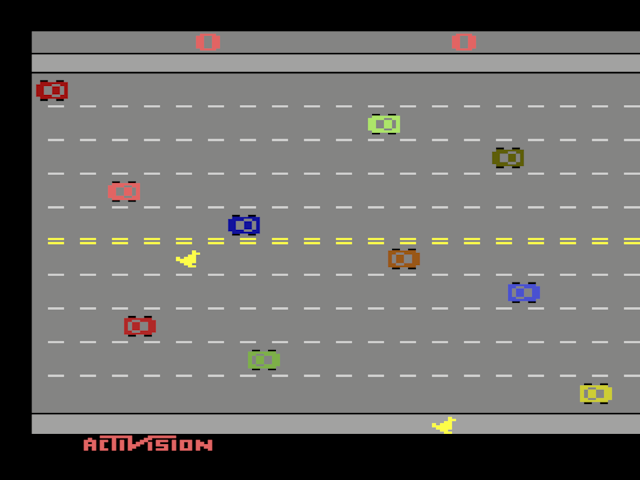 Nearly all the games worth playing from 1981 are arcade ports, but Activision’s Freeway for the Atari VCS is an exception. This unique game was inspired by David Crane hearing from co-workers about a man trying to cross a freeway in busy traffic without getting run over. The game was originally going to feature the man, but this was substituted for a chicken because the shock value of a man getting hit over and over by cars was a bit much for what Activision was trying to present to the public. The goal is to cross the freeway as many times as possible within the time limit. If you get hit by a car, it doesn’t hurt you, kill you, or even make you start over – it simply bumps you back and costs you time, incentivizing you to be very aggressive at crossing the road quickly. The game’s complexity gives it a lot of replay value for a 1981 title!
Nearly all the games worth playing from 1981 are arcade ports, but Activision’s Freeway for the Atari VCS is an exception. This unique game was inspired by David Crane hearing from co-workers about a man trying to cross a freeway in busy traffic without getting run over. The game was originally going to feature the man, but this was substituted for a chicken because the shock value of a man getting hit over and over by cars was a bit much for what Activision was trying to present to the public. The goal is to cross the freeway as many times as possible within the time limit. If you get hit by a car, it doesn’t hurt you, kill you, or even make you start over – it simply bumps you back and costs you time, incentivizing you to be very aggressive at crossing the road quickly. The game’s complexity gives it a lot of replay value for a 1981 title!
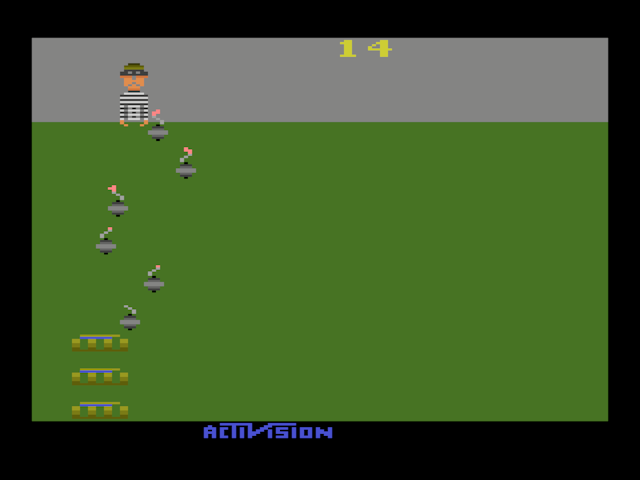 Another good Activision game released this year is Kaboom!, also for the Atari VCS, as all of Activision’s games still were at this point. While the core gameplay is clearly copied from the 1978 arcade game “Avalanche”, Kaboom! is different in focusing on short, intense bursts of objects (in this case, Bombs) to catch and prevent from reaching the bottom of the screen. This is a game that requires a lot of practice to get good at and a great deal of concentration, both of which I don’t personally have the patience for. But hey, it seems to be pretty good quality at least!
Another good Activision game released this year is Kaboom!, also for the Atari VCS, as all of Activision’s games still were at this point. While the core gameplay is clearly copied from the 1978 arcade game “Avalanche”, Kaboom! is different in focusing on short, intense bursts of objects (in this case, Bombs) to catch and prevent from reaching the bottom of the screen. This is a game that requires a lot of practice to get good at and a great deal of concentration, both of which I don’t personally have the patience for. But hey, it seems to be pretty good quality at least!
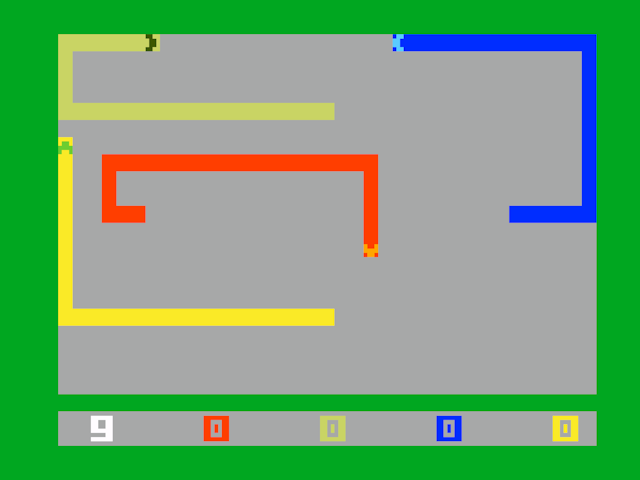 By far my favorite game released this year is, amazingly enough, for the Intellivision! Snafu is at its core another one of those run-into-a-trail games like the “Checkmate” game that I featured in 1978’s article. Snafu though has a number of fun game modes, including a completely different style of game where you try to chase after an enemy snake and munch at their tail! The game is I think most noteworthy for featuring actual background music, which was unheard of in console games back then. It gives the game a much more modern feel than its contemporaries.
By far my favorite game released this year is, amazingly enough, for the Intellivision! Snafu is at its core another one of those run-into-a-trail games like the “Checkmate” game that I featured in 1978’s article. Snafu though has a number of fun game modes, including a completely different style of game where you try to chase after an enemy snake and munch at their tail! The game is I think most noteworthy for featuring actual background music, which was unheard of in console games back then. It gives the game a much more modern feel than its contemporaries.
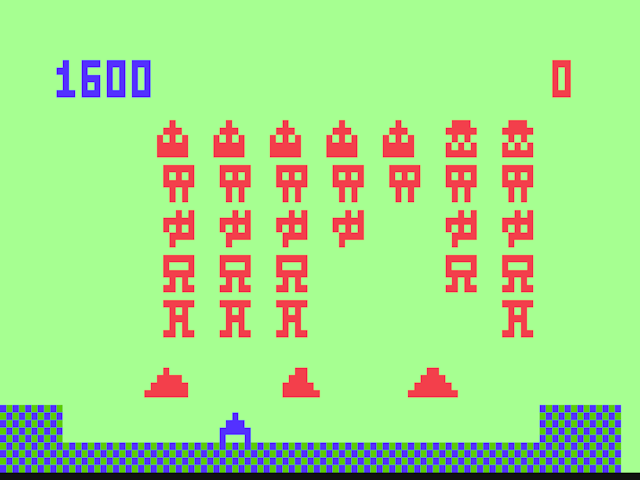 The last game on the list is a port of Space Invaders for the Fairchild Channel F called Alien Invasion. It’s not a particularly noteworthy game and while it’s not a good game, it’s not a bad game either. I’m including it in the list because it’s the last official, non-aftermarket title for the Fairchild Channel F, and because it illustrates quite nicely my theory for why the console was doomed. Most people just say it’s because of its terrible graphics, but I have a more nuanced theory than that myself.
The last game on the list is a port of Space Invaders for the Fairchild Channel F called Alien Invasion. It’s not a particularly noteworthy game and while it’s not a good game, it’s not a bad game either. I’m including it in the list because it’s the last official, non-aftermarket title for the Fairchild Channel F, and because it illustrates quite nicely my theory for why the console was doomed. Most people just say it’s because of its terrible graphics, but I have a more nuanced theory than that myself.
The Fairchild Channel F had a really cool controller that was unlike anything else on the market. It was easily the console’s biggest – and only – advantage over its competitors, because yes, its graphics were awful! If the Channel F guys had only played to their strengths, they’d have something to tell the market – something that made them special. That controller allowed for gameplay that no one else could imitate. If they’d gone that route, I think they would have been successful enough to justify a successor console, and maybe today the market would look very different! Instead though, only a few games at the beginning of the console’s life actually did anything to harness this controller’s power. Later games just tried to imitate the success of the Atari VCS, which of course the Channel F was terrible at doing, as can be seen from this greatly inferior Space Invaders port compared to Atari’s from last year. And the rest is history.
I think that’s a lesson to modern companies not to try and imitate the success of others. I see it happen time and time again, and imitators almost always fail at imitating. Instead, companies should focus on their strengths over their sexier competitors, find their niche, and in that way survive. That’s my opinion at least – I’m no businessdemon like they are!
Meanwhile in Arcade Land…
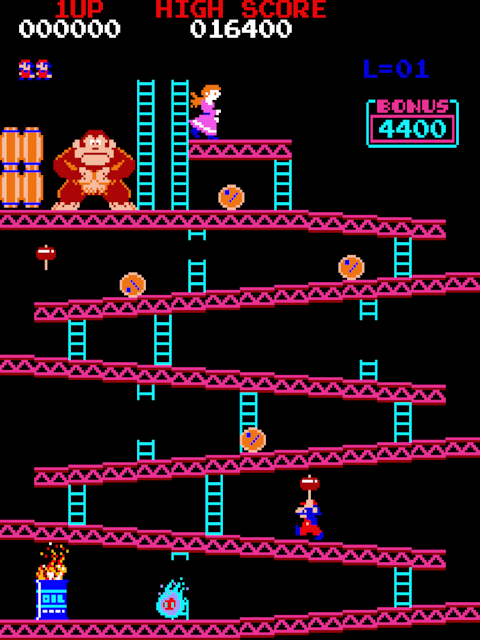 Maybe more than ever, arcade games were still where all the innovation was taking place this year. They became the reason for everything you saw happening in the console world, and so that context was critical for me. So I’m glad I decided to include them even with how much time they’ve taken up so far compared to console games.
Maybe more than ever, arcade games were still where all the innovation was taking place this year. They became the reason for everything you saw happening in the console world, and so that context was critical for me. So I’m glad I decided to include them even with how much time they’ve taken up so far compared to console games.
This was an incredible year for arcade games, and there were a LOT of amazing titles with unique concepts I could have included here, but the all-famous Donkey Kong is still the obvious choice! Donkey Kong was powerfully influential not just on the console games of the day, but carrying forward to the present. In fact, I think there is a good case to be made that Donkey Kong is the single most influential game in history!
 In Donkey Kong, you play the character of Jumpman, who would later mutate into the Mario character we know today. I would argue he was also the precursor to Wario as well. Unlike the jolly and heroic Mario, Jumpman was not a very friendly or nice person, and he happened to own a pet gorilla named Donkey Kong who we can surmise was mistreated a lot. That gorilla escapes, kidnaps Jumpman’s girlfriend, “Lady” (since retconned to be her own character but clearly the predecessor to Princess Peach at the time) to protect himself, then flees from Jumpman up a construction site. It’s up to Jumpman to use his jumping and carpentry skills to rescue the girl, recapture his pet gorilla, and clean up the mess he made – though that seems to involve the total destruction of said construction site…
In Donkey Kong, you play the character of Jumpman, who would later mutate into the Mario character we know today. I would argue he was also the precursor to Wario as well. Unlike the jolly and heroic Mario, Jumpman was not a very friendly or nice person, and he happened to own a pet gorilla named Donkey Kong who we can surmise was mistreated a lot. That gorilla escapes, kidnaps Jumpman’s girlfriend, “Lady” (since retconned to be her own character but clearly the predecessor to Princess Peach at the time) to protect himself, then flees from Jumpman up a construction site. It’s up to Jumpman to use his jumping and carpentry skills to rescue the girl, recapture his pet gorilla, and clean up the mess he made – though that seems to involve the total destruction of said construction site…
Donkey Kong is what today we would call a platformer, where you jump around and battle enemies, though that term didn’t exist back then, because Donkey Kong was the platformer – the first platformer! So not only was it the birth of what is easily the most well-known gaming franchise in existence today, but it was the start of what has since become probably the most popular genre of console games! Certainly, it’s my favorite genre! I’m looking forward to later years and seeing the powerful mark of influence Donkey Kong will have on the entire industry.
Conclusion
I never intended to get as far with this project as I have, and this may be the last year I finish. 1982 has 459 games for me to get through, roughly 3/4 the number of games I’ve already played in the project so far! So if I ever finish it at all, it will be a long time before a 1982 article is available. Wish me luck!